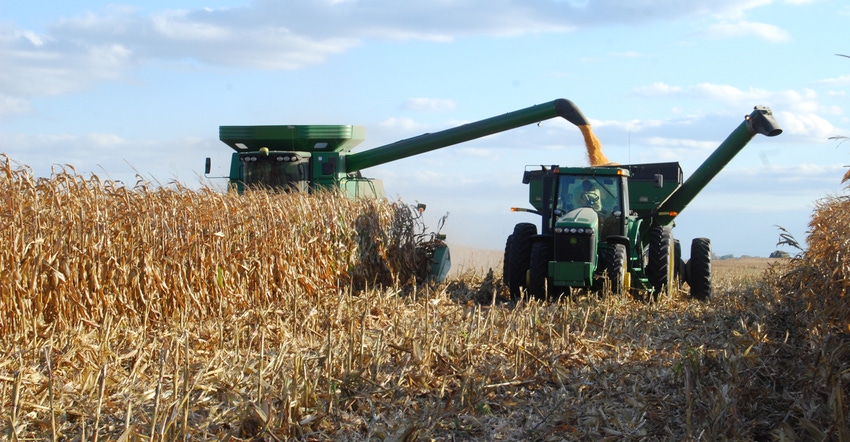October 25, 2017

The near ideal growing conditions in late summer and early fall this year benefited Iowa’s corn and soybean yields, as well as crop quality. However, the crops are maturing later than normal. This leaves much of Iowa’s corn harvest to stretch beyond October well into November. The harvest was a week or two late getting started, and higher corn moisture levels are adding to shrink losses and drying costs.
Rather than take discounts for delivery of corn above 15% moisture content, many farmers will let their crop dry down naturally in the field before harvesting. ISU Extension research indicates that unharvested corn could dry at a rate of 0.3 point of moisture per day in wet, cool weather during the fall. Drydown improves to 1 point of moisture per day in hot, dry weather. This reduces the cost of artificially drying the crop, but it may delay harvest and result in additional stalk lodging and potential ear loss.
Why deliver wet corn at harvest?
Cash flow constraints and lack of adequate on-farm storage are two reasons why some farmers may choose to deliver corn at harvest above 15% moisture content. Lack of adequate on-farm and commercial drying capacity are other possible reasons for making cash sales. Farmers may choose to deliver corn above 15% moisture, accepting a discounted price but avoiding additional shrink losses, as well as drying costs. Commercial storage requires that the corn be adjusted to 14% moisture to be placed under warehouse receipt.
The farmer making cash corn sales could still choose to use a minimum price contract to improve the final settlement price. This likely anticipates a futures price rally in the deferred contracts, likely targeting May or July ’18 corn futures.
Comparing cash sales with moisture discount
Iowa State University has a decision tool found online you can use to compare selling your corn at harvest versus the shrink loss, drying and storage costs you would incur by drying and storing corn. Using the ISU Extension Ag Decision Maker decision tool, titled “Corn Drying and Shrink Comparison,” File A2-32, you plug in your own information and assumptions. Here’s how it works.
Step 1. Variable cost estimate for on-farm drying. Choose a drying system and input your variable costs. Those are propane, electricity, drying time labor, drying capacity, average points of moisture removed per bushel, total bushels per year and total investment in drying system.
Step 2. Yield and moisture projections for unharvested corn. Input your own decisions regarding acres harvested, wet gross bushel yield, corn moisture in field, days before harvesting and expected cash grain price at harvest.
Step 3. Compare your grain sale alternatives at harvest. You can sell wet corn and incur a moisture discount; dry the grain commercially and then sell; or dry it on-farm and sell it.
Step 4. Input your own final moisture level for commercial sale, moisture discount for wet corn sale, commercial drying charge and shrink factor. You might want to consider additional on-farm costs for drying and hauling.
Step 5. Input your own sales alternatives following storage. This includes for the number of months grain will be stored, cash price paid after storage, moisture level for storage, minimum charge for commercial storage, base rate in months, monthly minimum charge commercial storage after minimum, quality deterioration on-farm storage, fans, electricity, labor on-farm storage and short-term interest rates.
This Corn Drying and Shrink Comparison, available on ISU’s AgDM website, is a decision tool that uses assumptions and compares net revenue after storage costs and the breakeven selling price needed to pay storage costs.
The ISU information files (pdfs) and decision tools (Excel spreadsheets) were developed by ISU economics Emeritus Professor William Edwards. They are:
• Estimating the Cost for Drying Corn, File A2-31
• Corn Drying and Shrink Comparison, File A2-32
• Cost of Storing Grain, File A2-33
Keep these key points in mind: 1) Wet grain at harvest may result in higher shrink losses and drying costs; 2) Your concerns for adequate on-farm and commercial drying and storage capacity; 3) A decision tool from ISU Extension helps compare corn sales with moisture discounts.
Johnson is an Iowa State University Extension farm management specialist. Contact him at [email protected].
About the Author(s)
You May Also Like






